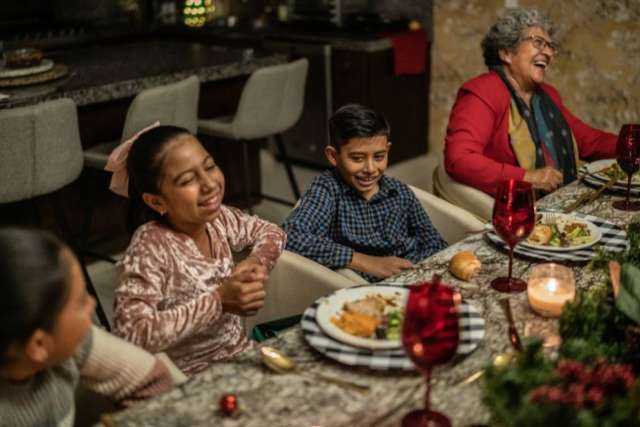Pumpkin pie. Parties. Presents.
There’s a lot to love about the holidays. But for children with anxiety, this festive season can be fraught with worry-inducing disruptions and new experiences, says Kate Sheehan, LCSW, managing director of the UCLA Center for Child Anxiety Resilience Education and Support.
“Even though we think of the holidays as mostly a pleasant time, there’s a lot of uncertainty and a lot of newness and a lot of unpredictability,” Sheehan says. “And anxiety really thrives on all of those.”
Anxiety is something we all experience, she says, but for some of us, it reaches levels that disrupt everyday life and prevent us from doing things we want or need to do. Because anxiety is natural, it can be hard to recognize when it’s become too much — especially amid the hubbub of the holidays.
There are three phases of holiday-related anxiety to look out for, Sheehan says: the period leading up to group gatherings, the events themselves and the post-holiday adjustment back to school.
Pre-holiday worries
Children might express anxiety about upcoming celebrations by asking lots of questions or seeming less than enthusiastic about family plans, Sheehan says. She suggests listening for repeated inquiries such as: Do we have to? Who’s going to be there? How long do we have to stay?
“We can look at that as a skill we want kids to have — to be able to think ahead and plan ahead — and the adults can fill in any of the uncertainty that doesn’t need to be there,” Sheehan says. “We usually hold a lot more information than we realize and anxiety is just looking for any gaps. So the more we can fill in the gaps, that can reduce some of that anticipatory anxiety.”
Parents can help allay a child’s social anxiety by preparing them to engage with relatives they may not have seen for awhile: What’s a story they could tell or a school happening they might share?
“For kids who don't get a lot of practice talking to people they don't see very often, or strangers even, acknowledging how anxiety provoking that can be and helping them take a little step forward with it can help them feel less anxious,” Sheehan says. “When they have a plan, it sets them up to succeed.”
It can also be helpful to chip away at uncertainty by explicitly naming those unknowns that might be fun, like, “I wonder what kind of pie Grandma is going to make this year?”
“Even though we think of the holidays as mostly a pleasant time, there’s a lot of uncertainty and a lot of newness and a lot of unpredictability.”
Kate Sheehan, managing director of the UCLA Center for Child Anxiety Resilience Education and Support
This allows the uncertainty itself to be spoken about, Sheehan says, which normalizes and defangs it.
“You’re not doing life wrong if you don’t know everything,” she says. “That’s just life.”
Holiday travel often generates uncertainty, as well. This is where mindfulness skills can be helpful, Sheehan says.
Mindfulness — the practice of noticing the present moment with curiosity and without judgement — is naturally calming, even if the present moment is uncertain or uncomfortable.
One tool Sheehan recommends is the “butterfly breath” focused breathing technique. It involves tracing the outline of a butterfly (or a figure-eight), inhaling as you trace half the butterfly and exhaling as you do the other. This slows the breathing and creates present-moment awareness.
Another strategy is to be curious about your surroundings. For example, if you’re in the airport waiting to board a flight, how many different languages or accents do you hear around you? How many people of different ages do you see? If traveling by car, you might try noticing what colors are around you, counting how many blue cars pass by or spotting different kinds of license plates.
“It’s being able to focus on something outside yourself,” Sheehan says. “Because inside yourself is all of that anxiety just rumbling away.”
During holiday festivities
It’s easy for children (and adults) to get overstimulated without noticing it until it becomes overwhelming, so it’s important to build downtime into holiday visits, Sheehan suggests.
When there’s a lot of noise and excitement and socializing going on, intentionally engaging in a quiet activity can be stabilizing and restorative. Maybe parent and child can plan to go for an afternoon walk together or take a reading break during the day.
Sheehan recommends “coming up with a game plan for how to give ourselves a little bit of breathing room.”
“Then if you don't need it, you don't need it,” she says. “But it's really hard to kind of plug it in if you haven’t given it thought ahead of time.”
Post-holiday transition
The transition back to school brings its own challenges for anxious kids, Sheehan says. Children might worry that their winter break won’t match up to their classmates’ amazing vacations. They may fear judgement that their holidays “weren’t good enough,” Sheehan says.
“Some kids might only remember the parts of school that they don’t like,“ she says, “and during the break they forget all the parts they do like.”

Help defuse this anxiety by prompting the child to think about who they’re looking forward to seeing at school and identifying an anecdote from the holidays to share. Parents might also open up about the post-holiday transition back to work being challenging, too.
“You might say, ‘Oh it’s so hard to go back. But I’m really looking forward to seeing this one colleague. And I was trying to remember: Didn’t something funny happen at Grandma’s? I was going to try to tell that story when I get back to work,’” Sheehan offers. “It’s just helping them think of something specific to hold onto.”
Tending to sleep schedules is also important, she says. Sticking close to regular bedtimes during the holiday break — or at least in the days leading up to the return to work or school — will make the transition easier.
The holidays and post-holiday period is also a good time to introduce gratitude practices, Sheehan says. Noticing what we’re thankful for is a mood booster anytime, but can be particularly helpful to counteract anxious thoughts before bed or during transitional times, she says.
She recommends making the practice tangible with a beaded bracelet or our own hands — as you touch each bead or finger, name something you are grateful for.
“They can be tiny things,” she says. “Like I’m thankful I’m here in bed and I’m warm. I’m thankful that people I love are nearby.
“When we’re naming something we’re grateful for, it’s something that we know. It’s not uncertain at all. So it’s a counterbalance to that anxiety.”
Learn more about UCLA CARES’ tips for anxious children.



